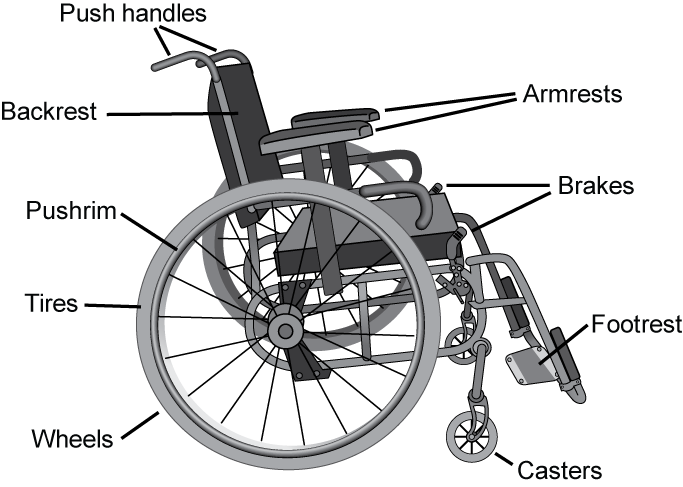
Introduction
The wheelchair is a complex piece of equipment that has been extensively engineered and studied. Most individuals with SCI become wheelchair experts because doing so increases their chances of getting a wheelchair that truly meets their needs. However, there are numerous options when considering a manual wheelchair, so it is critical to get help (see the SCI Model System Consumer Information guide Getting the Right Wheelchair: What the SCI Consumer Needs to Know). While it is not possible to teach you all there is to know in a single handout, this factsheet includes some of the most important information.
Why Choose a Manual Wheelchair?
If you have enough function to propel a manual wheelchair, it is probably the best form of mobility. Manual wheelchairs are easy to transport, need fewer repairs, and provide a form of exercise. However, they are not for everyone; you need to have the ability to propel. Most people with an injury level below C6 can propel a manual chair and some individuals with a C6 level can as well; this will be dependent on your weight, fitness, strength, level of pain, and the environment in which you need to push. While manual wheelchair propulsion can be a form of exercise, it can also lead to arm injuries from repetitive use. This risk makes it critical to get the right chair, to set it up correctly and to learn how to effectively propel.
Features and Components
Weight
Wheelchairs are generally classified by Medicare (which sets the industry standards) as lightweight (less than 34 lbs.) and ultralight (less than 30 lbs.). (These weights do not include footrests or armrests.)
Lightweight chairs are often not adjustable and are not recommended for SCI. Ultralight chairs are more expensive than the lightweight chairs, are highly adjustable, and incorporate many design features that improve mobility and comfort. Adjustability allows the wheelchair to be set up for optimal propulsion efficiency, which can reduce the risk of injury. It is harder to get insurance companies to pay for this type of wheelchair. Clinical practice guidelines recommend the lightest chair possible. Titanium and aluminum chairs can weigh under 20 lbs.
Frames
Frames may be folding or rigid. Rigid frames tend to perform better when maneuvering. Folding frames are often easier to transport, although many rigid chairs can get to a very small size by removing the wheels and folding down the backrest.
Components
Many components (Figure 1) are important for wheelchair function. These components come in a variety of styles, and selection depends on your needs, preferences and lifestyle.

Figure 1. Wheelchair Components
- Footrests support your feet and lower legs. They can be fixed, folding or swing-away and come in many different styles.
- Armrests are places to rest your arms when you’re not moving. They can be wraparound, full-length or desk-length; fixed or height-adjustable; removable or flip-back. Fit is important because armrest position can alter the way you propel your wheelchair. Many individuals choose not to have armrests because they don’t like the way they look or they get in the way of propulsion.
- Wheel locks act as parking brakes to stabilize your wheelchair when you transfer to other seats or want to remain in a particular spot. They may be push-to-lock or pull-to-lock, positioned low or high on the wheelchair, and retractable or not, depending on what the user finds easier. Wheel locks can get in the way during propulsion and add weight to the wheelchair. For this reason many individuals choose not to have wheel locks, relying on their hands to keep their chair still. Not having wheel locks can increase the risk of the chair moving during a transfer, however, which you should consider when making this decision.
- Tires are most commonly air-filled (pneumatic) and therefore lightweight. They also require maintenance and can puncture. If you maintain them, this is usually the best choice. Pneumatic tires may instead be filled with solid foam inserts; these won’t puncture but are slightly heavier and don’t perform as well. Solid tires are low-cost and no-maintenance, but make for an uncomfortable ride and are not usually recommended.
- Backrest: Sling backrests are the most common, but provide little postural support. Adjustable tension backrests can provide more support and can be adjusted over time. Rigid backrests provide the best support, but may make it more difficult to collapse the chair. The weight and height of the backrest are important. In general, the lighter the better, with carbon fiber backrests being a nice option. If support is not needed, a lower backrest is better as it does not get in the way of pushing.
- Cushions come in a huge and ever-changing array of different types and materials and comprise a major topic unto itself. While pressure relief is an important consideration when selecting a cushion, you should also keep in mind that you want a firm base and a light-weight cushion. A firm base refers to feeling stable, not sliding on the cushion when reaching for an object or propelling your chair.
- Pushrims: There are a variety of pushrims with different friction coatings and shapes that may assist with propulsion and reduce the risk of injury to the hand.
- Additional features include anti-tippers, wheels and caster wheels of various styles, push handles and grade-aids (which keep the chair from rolling backward).
Set-up and Fit
Set-up and fit of your wheelchair is critical to good performance.

- Seat height and width: If the fit is too tight, it can cause pressure sores; too wide, and it may cause problems with stability, posture and fitting through doorways. The seat height should make it easy to access the pushrim as well as transfer surfaces. To test this, let your hands dangle at your side when sitting in the chair: your fingertips should extend just past the chair’s axle.
- Seat slope is the difference between the front seat-to-floor height and the rear seat-to-floor height. It is common to have a slight seat slope (so buttocks are lower than your knees) to keep your body stable in your wheelchair.
- Rear axle position is important as it impacts how easy it is to push and tip your chair. In general you want the rear axle as far forward as possible (this will make it easier to push) without making the chair too easy to tip over backwards.
- Camber is the angle of the wheel with respect to the chair (Figure 2). A little camber is a good thing as it will protect your hands and increase your base of support. Too much camber will make it hard to fit through doorways.
Propulsion
Your therapist will train you on the best way to propel your wheelchair to be efficient and avoid injury. Long smooth strokes are better than short strokes, and the hand should drop below the push rim during the recovery (non-pushing) part of the stroke.
The Wheelie
Ask your physician for a referral to a therapist who can teach you how to “pop” and hold a wheelie. This skill can help you get through uneven terrain and over curbs. It can give you greater awareness of your balance point, which may decrease your chances of tipping over. When performing a wheelie, if your front wheels are more than two or three inches off the ground, your rear axle is probably too far back and could be adjusted forward.
Also in the SCI Model Systems Consumer Information Series on Wheelchairs:
- Getting the Right Wheelchair: What the SCI Consumer Needs to Know
- The Power Wheelchair: What the SCI Consumer Needs to Know
References
- Boninger ML, Cooper RA, Fay B, Koontz A, Musculoskeletal Pain and Overuse Injuries, in Spinal Cord Medicine: Principles and Practices, Demos Medical Publishing, NY, 2003.
Resources
- ABLEDATA is a non-commercial information center for assistive technology, including wheelchairs. Go to www.abledata.com (select Products, then Wheeled Mobility) or call 800-227-0216.
- Consortium for Spinal Cord Medicine, Preservation of Upper Limb Function Following Spinal Cord Injury: What You Should Know (Paralyzed Veterans of America, 2005).
- Gary Karp, Choosing A Wheelchair: A Guide for Optimal Independence (Cambridge, Mass: O’Reilly, 1998).
- Cooper RA, Olson J, Cooper RM, Manual Wheelchair Lingo, Paraplegia News, pp. 17-24, Vol. 63, No. 11, November 2009.
Authorship
The Manual Wheelchair: What the SCI Consumer Needs to Know was developed by Michael Boninger, MD, in collaboration with the Model Systems Knowledge Translation Center.
Source: Our health information content is based on research evidence whenever available and represents the consensus of expert opinion of the SCI Model System directors.
Disclaimer: This information is not meant to replace the advice from a medical professional. You should consult your health care provider regarding specific medical concerns or treatment.